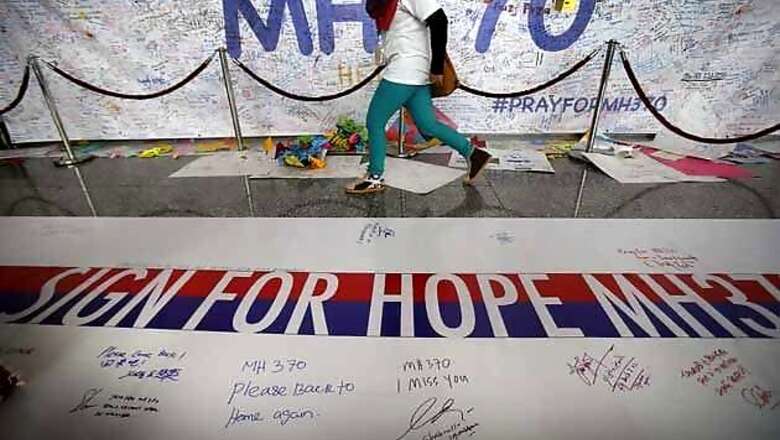
views
Kuala Lumpur: The search and rescue operation for the missing Malaysian Airlines flight MH370 has taken a new international dimension and the area has been to cover 2.24 million square nautical miles, said Malaysian official on Tuesday.
Official said the searches are happening in territories beyond Malaysia and the focus is now on huge areas over central asia and Indian ocean. The Malaysain government have requested other countries to come forward and help them.
China deployed 21 satellites to scour its territory for a missing Malaysian jetliner, while Australia said it had drastically narrowed its sector of the search area but was still looking in an expanse of ocean the size of Spain and Portugal.
Malaysia said it had conferred with the US and Chinese ministers on the search for Malaysian flight, an unprecedented 26-nation operation that now spans Asia from the Caspian Sea to the southern Indian Ocean.
Investigators are convinced that someone with deep knowledge of the Boeing 777-200ER and commercial navigation diverted the jet, carrying 12 crew and 227 mainly Chinese passengers, perhaps thousands of miles off its scheduled course from Kuala Lumpur to Beijing.
But intensive background checks of everyone aboard have so far failed to find anyone with a known political or criminal motive to crash or hijack the plane, Western security sources and Chinese authorities said.
China has begun to search for MH370 in Chinese territory, which falls within the northern search corridor, said state news agency Xinhua, and Foreign Ministry spokesman Hong Lei told a daily news conference that 21 satellites were involved.
"In accordance with Malaysia's request, we are mobilizing satellites and radar to search over the Chinese section of the northern corridor which the Malaysians say the plane may have flown over," he said.
Australia, which is leading the southernmost leg of the search, said it had shrunk its search field based on satellite tracking data and analysis of weather and currents, but that it still covered 600,000 sq km (230,000 sq miles).
"A needle in a haystack remains a good analogy," John Young, general manager of the emergency response division of the Australian Maritime Safety Authority (AMSA), told reporters.
"The aircraft could have gone north or south, and if it went south, this is AMSA's best estimate of where we should look with the few resources we have at our disposal for such a search."
Still looking for motive
China's ambassador to Malaysia said his country had carried out a detailed probe into its nationals aboard the flight, which vanished on March 8, and could rule out their involvement.
"The probe into the incident's cause is not suitable to be conducted in a high-profile way," Ambassador Huang Huikang told Chinese reporters, state television said on one of its official microblogs.
U.S. and European security sources said efforts by various governments to investigate the backgrounds of everyone on the flight had not, as of Monday, turned up links to militant groups or anything else that could explain the jet's disappearance.
A European diplomat in Kuala Lumpur also said trawls through the passenger manifest had come up blank.
One source familiar with US inquiries said the pilots were being studied because of the technical knowledge needed to disable the aircraft's communications systems.
Malaysian officials said on Monday that suicide by the pilot or co-pilot was a line of inquiry, although they stressed that it was only one of the possibilities under investigation.
Flight MH370 vanished from civilian air traffic control screens off Malaysia's east coast less than an hour after taking off from Kuala Lumpur.
Investigators piecing together patchy data from military radar and satellites believe that someone turned off the aircraft's identifying transponder and ACARS system, which transmits maintenance data, and turned west, crossing the Malay Peninsula and following a commercial aviation route towards India.
Thailand said on Tuesday a re-examination of its military data had picked up the plane re-tracing its route across Peninsular Malaysia. The Thai military had previously said it had not detected any sign of the plane.
What happened next is less certain. The plane may have flown for another six hours or more after dropping off Malaysian military radar about 200 miles northwest of Penang Island.
But the satellite signals that provide the only clues were not intended to work as locators. The best they can do is place the plane in one of two broad arcs - one stretching from Laos up to the Caspian, the other from west of Indonesia down to the Indian Ocean off Australia - when the last signal was picked up.
Flight simulator
Malaysian police have searched the homes of the captain, Zaharie Ahmad Shah, 53, and first officer, Fariq Abdul Hamid, 27, both in middle-class suburbs of Kuala Lumpur close to the airport.
Among the items taken for examination was a flight simulator Zaharie had built in his home.
A senior police officer with direct knowledge of the investigation said the programs from the pilot's simulator included Indian Ocean runways in the Maldives, Sri Lanka, Diego Garcia and southern India, although he added that U.S. and European runways also featured.
"Generally these flight simulators show hundreds or even thousands of runways," the officer said.
"What we are trying to see is what were the runways that were frequently used. We also need to see what routes the pilot had been assigned to before. This will take time, so people cannot jump the gun just yet."
Some US officials have expressed frustration at Malaysia's handling of the investigation. The Malaysian government still had not invited the FBI to send a team to Kuala Lumpur by Monday, two US security officials said.
China has also repeatedly voiced impatience with Malaysia's efforts.
Malaysia's Defence and Acting Transport Minister, Hishammuddin Hussein, told Reuters the country was co-operating with the FBI.
"I have been working with them," he said on Tuesday. "It's up for the FBI to tell us if they need more experts to help because it's not for us to know what they have."
Hishammuddin added that he had spoken to U.S. Defense Secretary Chuck Hagel and "my counterpart in China" about the search for the plane, now in its 11th fruitless day.
The US Navy is sending a P-8A Poseidon, its most advanced maritime surveillance aircraft, to Perth, in Western Australia, to assist with the search.
The disappearance of the plane was a major topic of conversation at the International Society of Transport Air Trading in San Diego, an annual gathering of 1,600 airplane makers, buyers and lessors.
"The people that I deal with are looking at this with great concern - it appears considerable efforts may have gone into cloaking the aircraft," said Robert Agnew, chief executive of aviation consultants Morten Beyer & Agnew.
(With additional information from Reuters)



















Comments
0 comment